 |
PO Box 9021,
Wilmington, DE 19809, USA
E-mail: font@focusonnature.com
Phone: Toll-free in USA 1-888-721-3555
or 302/529-1876 |
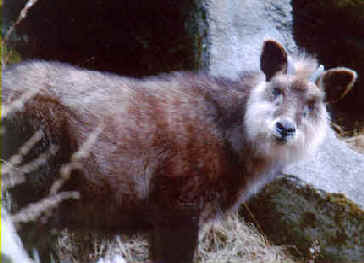 MAMMALS
MAMMALS
in Japan
noting those during
Focus On Nature Tours
1991 thru 2015
with an (*)
A List of
Land and Marine Mammals
in Japan
compiled by Armas Hill
In the list, Japanese names follow
those in English.
PHOTO AT RIGHT: A JAPANESE SEROW
photographed during a FONT tour on the island of Honshu
Codes:
AM: Amami Island
HK: Hokkaido
HN: Honshu
KY: Kyushu
NS: the islands of Nansei Shoto (from the ferry between Amami & Okinawa)
OK: Okinawa
(p): seen pelagically
(i/JA): introduced in Japan
(ph): species with a photo in the FONT
website
Links:
Upcoming
FONT Birding & Nature Tours in Japan
A List & Photo Gallery of Japan Birds, in 2 Parts:
Part #1: Pheasants to Pitta
Part #2: Minivets to
Buntings
A
List
of Japanese Butterflies (with some photos)
Directory
of Photos in this Website

List of Japanese Mammals:
PIKAS (in the Order Lagomorpha, Family Ochotonidae) (26 species worldwide)
- Northern Pika (Naki-usagi)
(ph) (*) ______ HK
(range: Siberia, northeast China, north Korea, and Hokkaido, Japan)
Ochotona hyperborea yesoensis
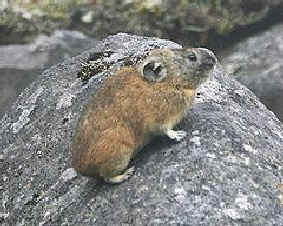
A Northern Pika in Hokkaido, Japan
RABBITS & HARES (in the Order Lagomorpha,
Family Leporidae) (57 species worldwide)
- Amami Rabbit (Amami-no-kuro-usagi)
(ph) (*) ______ AM
(endemic to Japan; on Amami Island only, endangered)
Pentalagus furnessi
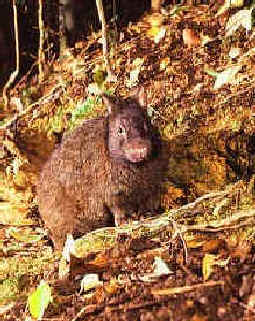
Amami Rabbit
- Japanese Hare (No-usagi) (*)
______ HN (endemic to Japan)
Lepus brachyurus brachyurus
Lepus brachyurus angustidens
Lepus brachyurus okiensis
Lepus brachyurus lyoni
- Mountain Hare (Yuki-usagi)
______ HK
Lepus timidus ainu
RODENTS:
gnawing mammals (Order Rodentia - the largest order of mammals with nearly 2,000
species
worldwide)
Families include:
Squirrels (Sciuridae)
Voles, Lemmings, and Muskrats (Arvicolinae)
True Mice & Rats (Muridae)
Dormice (Gliridae)
- Japanese Squirrel
(Nihon-risu) (ph) (*) ______
HN (endemic to Japan)
Sciurus lis
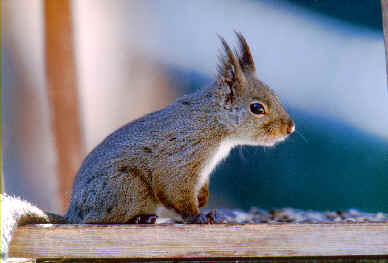
Japanese Squirrel
(photographed
by Paul West during a FONT tour in Honshu, Japan, April 2001)
- Eurasian Red Squirrel (Ezo-risu)
(*) ______ HK
Sciurus vulgaris orientis
- Siberian (or Asian) Chipmunk (Shima-risu)
(ph) (*) ______ HK
Tamias sibiricus lineatus
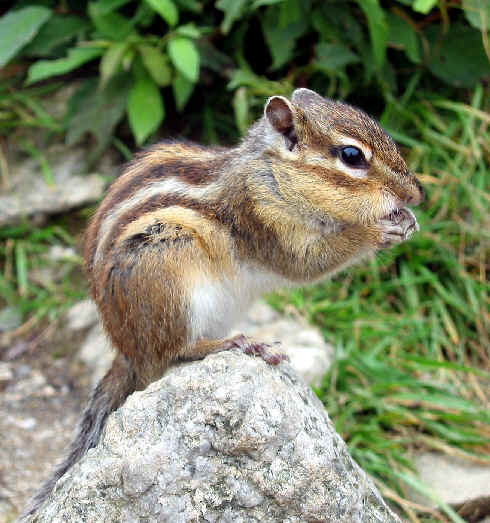
A Siberian Chipmunk in Hokkaido, Japan
- Grey-bellied Squirrel (Taiwan-risu) ______ (also
called Formosan Tree-Squirrel) (introduced in southern Japan:
Ryukyu Islands)
Callosciurus caniceps
- Japanese Flying Squirrel ______
HN,KY (endemic to Japan)
Pteromys momonga
- Siberian Flying Squirrel (Momonga)
______ HK
Pteromys volans orii
- Japanese Giant Flying Squirrel (Musasabi) (*) ______ HN
Petaurista leucogenys
- Japanese Grass Vole ______
Microtus montebelli
- Grey-sided Vole (*) ______ HK
Clethrionomys rufocanus bedfordiae
- Ruddy Vole ______
Clethrionomys rutilus mikado HK
- Japanese Red-backed Vole ______ HN
(endemic to Japan)
Phaulomys andersoni
- Smith's Vole ______ (endemic
to Japan)
Phaulomys smithiipermophilus mexicanus
- Korean Field Mouse ______ HK
(range: eastern Asia)
Apodemus peninsulae giliacus
- Large Japanese Fieldmouse (*)
______ KY
Apodemus speciosus
- Ryukyu Mouse ______ (range: southern
Japan, southern China, and Indochina)
Mus caroli
- Ryukyu Spiny Rat (Amami-togenezumi)
(*) ______ AM (has also been called the Amami Spinous
Mouse) (endemic to Japan, only on Amami Island, endangered)
Tokudaia osimensis
- Muennink's Spiny Rat
______ OK (endemic to Japan; only on Okinawa, critically endangered)
Tokudaia muenninki
- Brown Rat (*) ______ HK
(also
called Common Rat or, incorrectly, Norway Rat)
(introduced worldwide with human settlements, originally from southeast
Siberia & northern China)
Rattus norvegicus
- Ryukyu (Tree) Rat (Kenaga-nezumi)
(*) ______
AM (endemic to Japan, on Ryukyu
Islands)
Diplothrix (formerly Rattus)
legatus
- Japanese Dormouse (Yamana)
______
(endemic to Japan) (endangered)
Glirulus
japonicus
CARNIVORES (Order Carnivora)
Families include:
Genets & Civets: (Viverridae)
Mongooses: (Herpestidae)
Canines: Dogs & Foxes (Canidae)
Felines: Cats (Felidae)
Bears: (Ursidae)
Procyonids: Raccoons & allies (Procyonidae)
Mustelids: Weasels, Skunks & allies (Mustelidae)
GENETS & CIVETS (Family Viverridae) (37 species worldwide)
- Masked Palm Civet (Hakubishin) ______ (introduced
in Japan)
Paguma larvata
MONGOOSES (Family Herpestidae) (38 species worldwide)
- Small Indian Mongoose (*) ______ AM
OK
(introduced in Ryukyu
Islands, Japan)
Herpestes auropunctatus
- Indian Grey Mongoose (*) ______ OK
(introduced, locally in Ryukyu islands, Japan)
Herpestes edwardsii
CANINES, Dogs & Foxes (Family Canidae): (35 species worldwide)
- Red Fox (Kitsune)
(ph) (*) _____ HK HN
(considered conspecific with the Red Fox
in North America, Vulpes vulpes fulva)
Vulpes vulpes schrencki (subspecies
on Hokkaido)
Vulpes vulpes japonica (subspecies
on other
Japanese islands)

Red Fox
(photo by Doris Potter)
- Raccoon Dog (Tanuki)
(ph) (*) ______ HN KY
Nyctereutes procyonoides albus (subspecies on
Hokkaido)
Nyctereutes procyonoides viverrinus (subspecies on
Honshu & Kyushu)

Raccoon Dogs, as seen during FONT tours in Kyushu, Japan
The animal, actually a canine and not related to Raccoons, is often
nocturnal.
FELINES, Cats (Family Felidae)
(39 species worldwide)
- Leopard Cat (Tsushima-yamaneko) ______ (also
called Small-eared Cat) (range:
Afghanistan to Korea, south to Vietnam, also Philippines) (in Japan, on
islands in the Sea of Japan)
Felis bengalensis euptilura
- Iriomote Cat (Iriomote-yamaaneko)
______ (endemic
to Japan; only on Iriomote Island)
Felis iriomotensis
BEARS (Family Ursidae)
(8 species worldwide)
- Asiatic Black Bear (Tsukinowaguma)
______
HN
Urus thibetanus
- Brown Bear (Higuma)
(ph) ______
HK
Ursus arctos yesoensis
(Ursus
arctos has also been Ursus horribilis)
The Brown Bear of Eurasia and the Grizzly Bear of North
America are now
considered by most as a single species.
- Polar Bear ______ HK
(has occurred in far-northern Japan, but very rarely)
Thalarctos maritimus
MUSTELIDS, Otters, Weasels, and Badgers (Family Mustelidae) (68 species
worldwide)
- Eurasian Otter (Nihon-kawa-uso) ______
Lutra lutra nippon
- Sea Otter (Rakko)
(ph) (*) ______ HK (endangered) (in
Japan, very rare)
Enhydra lutris
The Sea Otter, or Rakko, has been seen during
two recent FONT tours in Hokkaido, Japan, in 2010 &
2011.
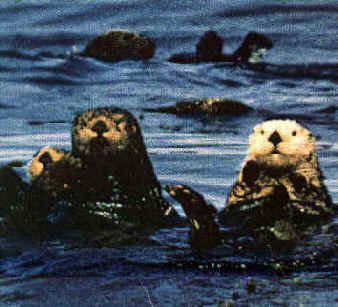
Sea Otters
- Japanese Marten (Ten) (*)
______ HK HN KY
Martes melampus
melampus (subspecies on
Honshu)
Martes melampus tsuensis (subspecies on the southern
Japanese island of Tsushima)
(another subspecies, Martes melampus
coreensis, occurs in Korea)
The Japanese Martin is
found in Japan throughout Honshu and Kyushu. It has been introduced in
Hokkaido.
Martes
melampus is also called the Yellow Martin.
Martens (this & the following species) look very much like weasels
(below), but they are larger and with a sturdier build.
The Japanese Marten is closely related to the Sable (below).
The Japanese Marten is omnivorous, preferring meat from fish, frogs,
and small birds and mammals, but it does also consume insects, fruit, and
seeds.
It sleeps in a den in a hollow tree or in a ground burrow.
The pelage of the Japanese Marten varies in color from a dark brown
to a dull yellow, with a cream-colored head and throat.
On average, it is 18 inches in length, not counting its 8 inch tail. Males
are generally larger than females.
- Sable (Kuro-ten) ______ HK
Martes zibellina
brachyurus
The Sable inhabits forests,
mostly in Russia from the Ural Mountains east throughout Siberia, and
also in eastern Kazakhstan, northern Mongolia and China, Korea, and in Japan
on the northern island of Hokkaido.
The body length of the Sable is 15 to 22 inches for males, and 14 to
20 inches for females. The animal has a long, bushy tail, from 3.5 to 5
inches in length, that is used for balance when climbing.
The Sable has had a reputation in Japan for being bad tempered and
aggressive.
- Stoat (or Ermine) ______
Mustela erminea
orientalis (subspecies
on Hokkaido)
Mustela erminea nippon
(subspecies on Honshu)
- Least Weasel ______
Mustela nivalis nivalis (subspecies
on Hokkaido)
Mustela nivalis namiyae (subspecies
on Honshu)
- Japanese Weasel ______
Mustela itatsi
Mustela itatsi is often
classified as a subspecies of the Siberian Weasel, Mustela
sibirica. The two are very similar in appearance, but differ
in the ratio of tail length to head and body length. There are also genetic
differences suggesting that the two diverged around 1.6 million years ago.
Their ranges now overlap in western Japan where the Siberian Weasel has
been introduced.
The Japanese Weasel is found on the Japanese islands of Honshu,
Kyushu, and Shikoku. It has been introduced in Hokkaido and on some Ryukyu
islands to control rodents.
Outside Japan, it has been introduced on Sakhalin Island in Russia.
The Japanese Weasel typically occurs in mountainous, forested areas
near water. Its diet includes mice, reptiles, insects, and crayfish.
The fur is orange-brown with darker markings on the head. Adult males can
have a body length up to 14 inches in length, with a tail length up to 6.5
inches. Females are smaller.
- Siberian Weasel (i/JA) ______
Mustela sibirica
Regarding Mustela
sibirica in Japan, see note above.
- Eurasian Badger (Ana-guma) (*) ______
HN
Meles meles anakura
The Eurasian Badger is a terrestrial
animal that burrows.
MOLES, SHREW-MOLES, and DESMANS (Family Talpidae) (42 species worldwide)
- Echigo Mole
______ (endemic to Japan; only on Echigo Plain on Honshu, endangered)
Talpa (formerly Mogera) etigo
- Tokudoa's Mole ______
(endemic to Japan; only
on Sado Island, endangered)
Talpa (formerly
Mogera) tokudae
- Japanese Mole
______ (endemic
to Japan)
Talpa (formerly Mogera) wogura
- True's Shrew-Mole (*) ______ KY
(endemic to Japan)
Urotrichus pilirostris
- Japanese Shrew-Mole (*) ______ KY
(endemic to Japan)
Urotrichus talpoides
SHREWS (in the Order Soricodae, Family Soricidae) (335 species worldwide)
- Eurasian Least Shrew ______ HK
(range:
northern Europe east to eastern Siberia, Korea, and Hokkaido, Japan)
Sorex minutissimus hawkeri
- Sado Shrew
______ (endemic to Japan; on Sado Island, endangered)
Sorex sadonis
- Lesser White-toothed
Shrew ______ (range: Europe east to
Japan & Taiwan) (in Japan, only on islands in Sea of Japan)
Crocidura suaveolens shantungensis
- Asian House Shrew ______
(range: Afghanistan to China, & Japan & Taiwan)
Suncus murinus
BATS (Order Chiroptera - with about 950 species worldwide, the
diversity of bats is second only to that of rodents)
Old World Fruit Bats (Family Pteropodidae) (177 species in the Old World)
- Bonin Flying Fox ______ (endemic
to Japan; only on Bonin & Volcano Islands, critically endangered)
Pteropus pselaphon
- Ryukyu Flying Fox (O-komon) (*) ______ OK
(range: in Japan, southern Kyushu & Ryukyu islands, also
Taiwan; endangered)
Pteropus dasymallus
dasymallus
Pteropus dasymallus inopinatus (subspecies on
Okinawa)
Pteropus dasymallus daitoensis
Pteropus dasymallus yayeyamae
Horseshoe Bats (Family Rhinolophidae)
(145 species worldwide)
- Little Japanese Horseshoe Bat
(*) ______ HN (endemic
to Japan)
Rhinolophus cornutus
- Greater Horseshoe Bat ______ (range: across
Eurasia)
Rhinolophus ferrumequinum
- Lesser Roundleaf Bat ______ (range:
in Japan, southern Ryukyu islands, also Thailand; endangered)
Hipposideros turpis
Free-tailed Bats (Family Molossidae) (94 species worldwide)
- Latouche's Free-tailed
Bat ______ (range: most commonly China & Thailand, but has occurred on
Ryukyu islands, southern Japan)
Tadarida latouchei
Vesper Bats (Family Vespertilionidae) (364 species worldwide)
- Eastern Barbastelle ______
Barbastella leucomelas darjelingensis
- Brown Long-eared Bat ______
Plecotus auritus
- Savi's Pipistrelle ______ (range:
southern Europe east to China & Japan, south to India & Myanmar)
Pipistrellus
(formerly Hypsugo) savii
- Japanese Pipistrelle (*)
______ HN (also called
Japanese House Bat)
Pipistrellus agramus
- Endo's Pipistrelle ______ (endangered)
Pipistrellus endoi
- Bird-like Noctule ______
Nyctalus aviator
- Big-footed Myotis ______
Myotis macrodactylus
- Natterer's Bat ______
Myotis nattereri
- Fraternal Myotis ______ (range:
Afghanistan east to Japan)
Myotis frater
- Okinawa Myotis ______
(endemic to Japan, only on Okinawa)
Myotis yanbarensis
- Greater Tube-nosed Bat ______ (range:
Kazakhstan east to Japan)
Murina leucogaster hilgendorti
- Ussuri Tube-nosed Bat ______
(endangered) (range: eastern Siberia, Korea, and Japan)
Murina ussuriensis
silvatica
- Ryukyu Tube-nosed Bat ______ (endemic
to Japan; on Ryukyu islands)
Murina ryukyuana
- Gloomy Tube-nosed Bat ______ (endemic
to Japan; on Tsushima Island, critically endangered)
Murina
tenebrosa
OLD WORLD MONKEYS (in the Order Primates, the Family Cercopithecidae) (132
species in the Old World)
- Japanese Macaque (Nihonzaru)
(ph) (*)
______ HN,KY
(endemic to Japan) (popularly
called "Snow Monkey")
Macaca fuscata
fuscata (subspecies
on Honshu & Kyushu)
Macaca fuscata yakui (subspecies
in the Ryukyu islands)
The Japanese Macaque occurs on
all of the main Japanese islands except for Hokkaido.
It is semi-arboreal, spending about equal amounts of time on the ground and
in trees. it can leap quite well, and often makes shrieking sounds as it
does.
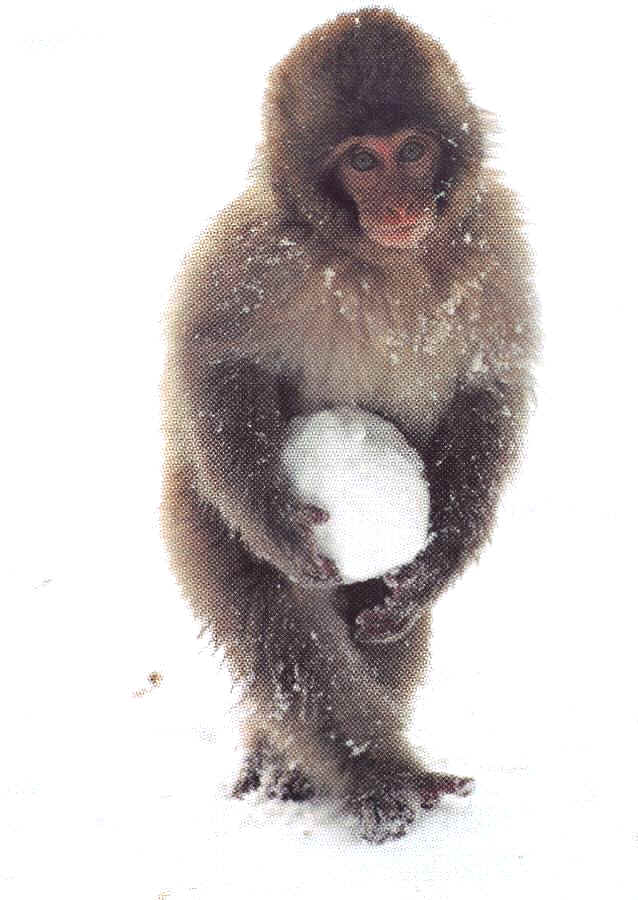
A Japanese Macaque, or
"Snow Monkey"
EVEN-TOED UNGULATES (Order Artiodactyla)
This order worldwide is diverse, including: pigs, hippopotamuses, camels,
deer, antelope, and cattle.
PIGS (Family Suidae)
(17 species in the Old World)
-
Eurasian Wild Boar (Inoshishi) (*) ______
HN,KY,AM,OK
Sus scrofa leucomystax (*) (Honshu &
Kyushu)
Sus scrofa riukiuanus
(*) (Amami, Okinawa)
DEER (Family Cervidae)
(47 species worldwide)
- Sika Deer (Shika) (ph) (*) ______ HK,KY (range:
native to forests of eastern Siberia, Korea, eastern China, and Japan)
Cervus nippon yesoensis (*) (Hokkaido)
Cervus nippon centralis (Honshu)
Cervus nippon nippon (*)
(Kyushu)
Cervus nippon pulchellus (Ryukyu Islands)
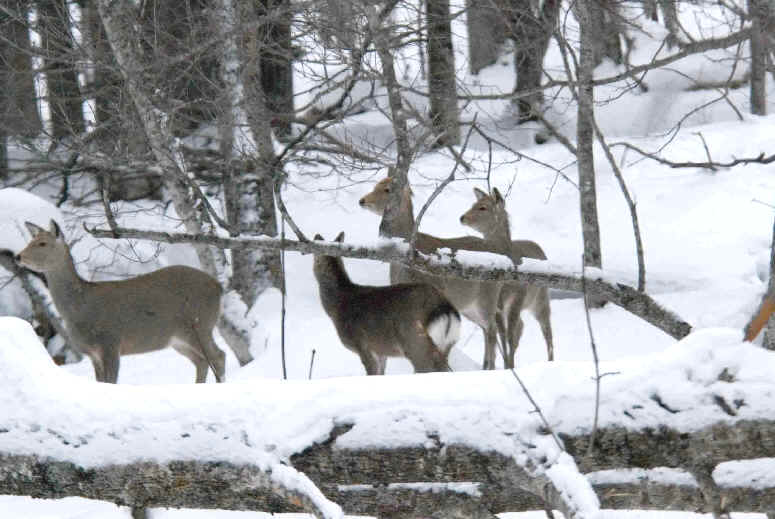
Sika Deer in the woods in Hokkaido,
photographed during the FONT Jan/Feb 2009 Tour in Japan
(photo by Karl Frafjord)
SHEEP, GOATS, BISON, & MUSKOX (Family Bovidae) (141 species
worldwide)
- Japanese Serow (Kamoshika)
(ph) (*)
______ HN (endemic to Japan)
Capricornis crispus
In the genus Capricornis, according to recent taxonomy, there are 6
species of these goat antelopes:
Capricornis crispus, the Japanese Serow, restricted to Japan
Capricornis milneedwardsii, the Chinese Serow, in China and some
southeastern Asian countries
Capricornis rubidus, the Red Serow, restricted to Myanmar, or Burma
Capricornis sumatraensis, the Sumatran Serow, in Indonesia, Malaysia, and
southern Thailand
Capricornis swinhoei, the Formosan Serow, restricted to Taiwan (at one time
conspecific with the Japanese Serow)
Capricornis thar, the Himalayan Serow, along the Himalayan range
The Japanese Serow is slightly smaller than the Capricornis species of
mainland Asia, with, generally, woollier and thicker fur and a more bushy
tail. It lacks the heavy mane of the mainland forms.
At one time, the Japanese Serow existed throughout much of the higher
forested regions of the Japanese islands of Honshu, Shikoku, and Kyushu. But
it is now restricted to some mountainous areas of central and northern Honshu, and only very
small numbers remain in eastern Shikoku and in Kyushu.
The Japanese Serow became extinct in western Honshu by the early 20th
Century.
In Kyushu, the already low population is decreasing further. That may be due
to interspecific competition with Sika Deer. The deer population on
Kyushu has recently been increasing.
Back in the early 20th Century, the considerable reduction of original forests
greatly reduced the habitat of the serow, an animal of woodlands.
Also serow meat was said to be more tasty than sika venison, and so
Capricornis crispus was heavily hunted. Its skin was popularly used as carpet.
By 1924, only a few Japanese Serow remained. In that year, the animal
was declared by the Japanese government to be a special natural monument,
thus according it complete protection against hunting and capture. Later,
several reserves were established for the species' protection. Those
measures eventually proved effective and enabled the population to build up
to an estimated 1,500 in the 1960s.
In the 1970s, the Japanese Serow population increased more
substantially. Among other factors, an increase in young conifer plantations
at that time supplied more food for the serow, causing a population
growth. By 1983, the total population was estimated as having gone up to
70,000 and maybe higher.
Today, the population of Capicornis crispus
in Japan is assumed to be stable or slightly
increasing.
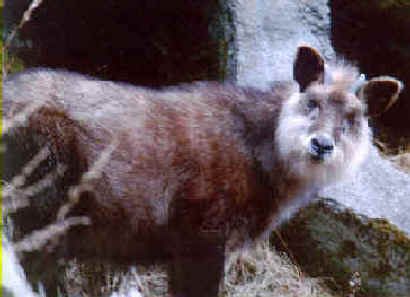
Japanese Serow
MARINE MAMMALS I - SEALS & SEA LIONS (Order Pinnidedia,
"fin-footed")
EARED SEALS, including SEA LIONS & FUR SEALS (Family Otariidae)
(14 species worldwide)
- Steller's (or Northern)
Sea Lion (Todo) (*) ______ HK
Eumetopias jubatus
Males of the Steller's Sea Lion are nearly 10 feet long, and can weigh up to 2,200 pounds; females
up 6.6 feet in length, and weighing up to 660 pounds.
- Northern Fur Seal (Ottosei)
(ph) (*) ______ HK,HN(p)
Callorbinnus ursinus
EARLESS SEALS (Family Phocidae) (20 species worldwide)
- Harbor Seal (Gomafu-azarashi)
(ph) (*) ______ HK
Phoca vitulina stejnegeri
(this subspecies known as the Kurile Seal (Zenigata-azarashi) Phoca
kurilensis, by some
said to be a distinct species. It is larger and more sexually dimorphic)
Harbor Seals range from 3.9 to 5.9 feet in length, weigh
from 99 to 230 pounds.
- Largha
(or Spotted) Seal ______ HK
Phoca largha
- Ringed Seal ______ HK
Phoca hispida ochotensis
- Ribbon Seal (Kurakaka-azarashi) ______ HK
Histriophoca fasciata
- Bearded Seal ______
HK
Erignathus barbatus nauticus
- Northern Elephant Seal ______ HK
Mirounga angustirostris
Male Northern Elephant Seals can be over 16 feet in length,
and weigh up to 4,400 pounds; females weigh up to 1,760 pounds.
WALRUS (formerly in Family Odobenidae,
now in Family Phocidae)
- Walrus ______ HK
Odobenus rosmarus
SIRENIANS (Order Sirenia)
DUGONG (Family Dugongidae)
(1 species, in the Old World)
- Dugong ______ (in the Ryukyu
islands) (closely related to the manatees, or "Sea Cows")
Dugong dugon
MARINE MAMMALS II - PORPOISES, DOLPHINS, & WHALES (Order Cetacea)
TOOTHED WHALES (Suborder Odontoceti)
includes:
Dolphins & Porpoises, the Beaked Whales, Sperm Whales, the Beluga and
Narwhal.
MARINE DOLPHINS (Family Delphinidae) (34
species worldwide)
- Short-beaked Common Dolphin (ph) (*) ______ NS
(also
called "Saddleback Dolphin")
Delphinus delphis
- Long-beaked Common Dolphin (*) ______ KY
Delphinus capensis
- Common Bottle-nosed Dolphin (ph) (*) ______
NS
Tursiops truncatus
- Pantropical Spotted Dolphin ______
Stenella attenuata
- Striped Dolphin ______
Stenella coeruleoalba
- Spinner Dolphin ______
Stenella longirostris
- Frazer's Dolphin (ph) ______
Lagenodelphia hosei
- Rough-toothed Dolphin (*) ______ NS
Steno bredanensis
- Northern Right Whale Dolphin ______
Lissodelphis borealis
- Pacific White-sided Dolphin (Kama-iruka)
(*) ______ HK HN
Lagenorhynchus obliquidens
Pacific White-sided Dolphins are up to just over 7 feet in length; up to
about 200 pounds in weight.
- Risso's Dolphin (ph) (*) ______ (also
called Gray Grampus)
Grampus griseus
Risso's Dolphins are up to nearly 12 feet in length; up to 900
pounds in weight.
- Orca (ph) (*) ______ (has also been called Killer Whale or "Sea Wolf")
Orcinus orca
Male Orcas are up to 30 feet in length, females up to
27 feet; males weigh up to 5 tons, females up to 3 tons. The male's dorsal
fin can be 6 feet high; that of the female about 2 feet in height.
The Orca is one of the fastest swimming whales, with a maximum recorded speed of 30
knots maintained for 20 minutes.
- False Killer Whale ______
Pseudorca crassidens
- Pygmy Killer Whale ______
Feresa attenuata
- Melon-headed Whale ______
Peponocephala electra
- Long-finned Pilot Whale (ph) ______ (has also been called "Blackfish")
Globicephala melas
- Short-finned Pilot Whale (ph) ______
(has also been
called "Blackfish")
Globicephala macrorhynchus
Male Short-finned Pilot Whales are up to over 22 feet in length; females
up to over 16 feet long. Males weigh to to 2,640 pounds; females up to 1,760
pounds.
PORPOISES (Family Phocoenidae)
(6 species worldwide)
- Finless Porpoise ______
Neophocaena phocaenoides
- Harbor Porpoise (*) ______
Phocoena phocoena
- Dall's Porpoise (*) ______
Phocoenoides dalli
Dall's Porpoises are up to 6.6 feet in length, up to 330 pounds in
weight.
BEAKED WHALES (formerly
Family Ziphiidae,
now
Family Hyperoodontidae)
(21 species worldwide)
(Pelagic in habitat, most are poorly known)
- Stejneger's Beaked Whale ______
Mesoplodon stejnegeri
- Hubb's Beaked Whale ______ (temperate
coastal waters off NE Honshu, central Japan; also off western North America)
Mesoplodon carihubbsi
- Cuvier's Beaked Whale (ph) ______ (has also been called Goosebeak Whale)
Ziphius cavirostris
- Blainville's Beaked Whale ______
Mesoplodon densirostris
- Ginkgo-toothed Beaked Whale ______
(warm-temperate waters near Japan & Taiwan)
Mesoplodon ginkgodens
- Baird's Beaked Whale (ph) ______
Berardius bairdii
- Longman's Beaked Whale
______ (very few records from the southern Pacific & Indian Oceans,
recorded in far-southern Japan)
Indopacetus pacificus
GREAT SPERM WHALE (Family Physeteridae)
(1 species worldwide)
- (Great) Sperm Whale (ph) (*) ______ (has also been called Cachalot)
Physeter catodon
PYGMY SPERM WHALES (Family Kogiidae)
(2 species worldwide)
- Pygmy Sperm Whale (ph) ______
Kogia breviceps
- Dwarf Sperm Whale (ph) ______
Kogia sima
BALEEN WHALES -
whales without teeth
(Suborder
Mysticeti)
GRAY WHALE (formerly in its own
Family Eschrichtiidae,
now in the
Family Balaenopteridae)
- Gray Whale ______
(Other names:
"Mussel-digger", "Scrag Whale")
Eschrichtius robustus
Female Gray Whales are larger than males: females up to over 46 feet long, males up
to over 42 feet long; the animal's weight can be up to 33 tons
In the western Pacific, the population (off Korea) may now be extinct.
RORQUAL (or FINBACK) WHALES (Family Balaenopteridae)
(8 species worldwide)
- Humpback Whale (ph) (*) ______ NS
(winters in waters around Ryukyu islands)
Megaptera novaeanliae
Humpback Whales
are up to over 52 feet in length, weighing up to 44 tons.
- Northern Minke Whale (ph) (*) ______ (has also been called Piked Whale or
Lesser Rorqual)
Balacnoptera acutorostrata
Until 1998, the Northern Minke Whale
was considered conspecific with the population in the Southern Hemisphere,
now the Antarctic Minke Whale, B.
bonaerensis.
Minke Whales are up to about 30 feet in length,
weighing up to nearly 10 tons.
- Bryde's Whale (*) ______
Balaenoptera brydei
- Sei Whale (*) ______
Balaenoptera borealis
- Fin Whale (ph) (*) ______ (has also been called Common Rorqual)
Balaenoptera physalus
- Blue Whale (ph) ______ (has also been called "Sulphurbottom")
Balaenoptera musculus
The Blue Whale is the largest of all
mammals worldwide.
RIGHT
& BOWHEAD WHALES (Family Balaenidae)
(5 species worldwide)
- North Pacific Right
Whale ______ (endangered)
Balaena (formerly Eubalaena) japonica (formerly part of
Balaena (Eubalaena)
glacialis, and when so called the Northern Right
Whale)
- Bowhead Whale ______
(rarely south to Japan)
Balaena mysticetus
References for the above mammal-list include:
"Mammals of the World, A Checklist" by Andrew Duff & Ann
Lawson, published by Yale University Press, 2004.
"Mammals in Japan": Field Best Encyclopedia Vol. 12, 2002
"Eyewitness Handbook: Whales, Dolphins & Porpoises - a Visual Guide to
the World's Cetaceans", by Mark Carwardine, illustrated by Martin Camm,
1995
"World Guide to Mammals" by Nicole Duplaix
& Noel Simon, 1976
"The Encyclopedia of Mammals", edited by Dr. David Macdonald, 1984



 MAMMALS
MAMMALS









![]()